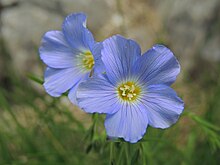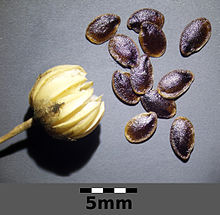Alpine flax
| Alpine flax | ||||||||||||
|---|---|---|---|---|---|---|---|---|---|---|---|---|

Alpine flax ( Linum alpinum ) |
||||||||||||
| Systematics | ||||||||||||
|
||||||||||||
| Scientific name | ||||||||||||
| Linum alpinum | ||||||||||||
| Jacq. |
The Alpine flax ( Linum alpinum ) is a plant from the genus flax ( Linum ) within the family Flax Family (Linaceae).
description
Vegetative characteristics
The alpine flax is a summer green, perennial herbaceous plant and reaches heights of 10 to 30 centimeters. The prostrate to upright stems are bare and densely leafed.
The alternately arranged leaves are sitting. The simple leaf blade is linear-lanceolate with a length of up to 25 millimeters.
Generative characteristics
The flowering period is from June to July. One to eight flowers are in a loose panicle inflorescence . The flower stalks are longer than the next leaf. The buds are nodding.
The hermaphroditic flowers are radial symmetry and five-fold with a double flower envelope . The five sepals are 5 to 7 millimeters long, with a bald skin edge and a short, attached tip. The light blue to whitish flower crowns have a yellow sap mark at their base . The five free petals are 12 to 20 millimeters long. There are two circles with five stamens each. The egg-shaped scars are no more than 0.8 millimeters long.
The upright or slightly inclined, ten-pod capsule fruit is 6 to 8 millimeters long. Each fruit compartment contains a blackish seed.
Chromosome set
The basic chromosome number is x = 9; there is diploidy or tetraploidy with a chromosome number of 2n = 18 or 36.
ecology
The alpine flax is a deciduous hemicryptophyte .
From an ecological point of view , these are disc flowers with ± hidden nectar , since the nectaries are located at the base of the stamens. Typical pollinators are insects: species of bees , bumblebees , wasps , woolly floats (Bombyliidae) and hoverflies (Syrphidae).
The diaspore is the seed.
Occurrence
The distribution area of Linum alpinum extends from the Pyrenees to the northern Urals . The alpine flax is a high mountain plant that thrives in the montane to alpine altitudes at altitudes of 1000 to 2000 meters.
In Central Europe, the alpine flax occurs in the northern and southern limestone chains, in the western Alps , Jura (mountains) . In Germany , where it occurs exclusively in Bavaria in the Berchtesgaden - Königssee area , it is classified in category 2 = highly endangered, highly endangered, and is particularly protected under the Federal Nature Conservation Act (BNatSchG).
The lime-loving plant inhabits limestone cliffs , limestone scree slopes and stony limestone grasslands in a sunny location. It is a character species of the order Seslerietalia (Alpine blue grass lawn, class Seslerietea albicantis).
Systematics
Linum alpinum was first published by Nikolaus Joseph Freiherr von Jacquin . Synonyms for Linum alpinum Jacq. are: Linum perenne subsp. alpinum (Jacq.) Stoj. & Stef. , Linum boreale Juz. , Linum komarovii Juz. , Linum komarovii subsp. boreal (Juz.) TVEgorova . The specific epithet alpinum means "from the Alps".
Depending on the author, there are several subspecies of the Linum alpinum species:
- Linum alpinum Jacq. subsp. alpinum : It only occurs with certainty in Bulgaria.
- Linum alpinum subsp. gracilius (Bertol.) Pignatti (Syn .: Linum alpinum var. gracilius Bertol. ): It occurs only in Italy.
- Linum alpinum subsp. julicum (Hayek) Hegi (Syn .: Linum julicum Hayek ) It occurs in France and Italy.
- Linum alpinum subsp. laeve (Scop.) Nyman (Syn .: Linum laeve Scop. , Linum montanum DC. nom. illeg., Linum alpinum subsp. montanum (WDJKoch) Bonnier & Layens , Linum perenne subsp. montanum (WDJKoch) Ockendon ): She comes safe in Switzerland, Germany, Austria, Liechtenstein, France, Bosnia and Herzegovina and Bulgaria.
- Linum alpinum subsp. pirinicum Petrova : It occurs only in Bulgaria.
use
Varieties are used as ornamental plants .
swell
literature
- Xaver Finkenzeller, Jürke Grau: Alpine flowers. Recognize and determine (= Steinbach's natural guide ). Mosaik, Munich 2002, ISBN 3-576-11482-3 .
- Manfred A. Fischer, Wolfgang Adler, Karl Oswald: Excursion flora for Austria, Liechtenstein and South Tyrol . 2nd, improved and enlarged edition. State of Upper Austria, Biology Center of the Upper Austrian State Museums, Linz 2005, ISBN 3-85474-140-5 .
Individual evidence
- ↑ a b Linum alpinum Jacq., Alpen-Lein. In: FloraWeb.de.
- ↑ a b c d e f g Alpen-Lein . In: BiolFlor, the database of biological-ecological characteristics of the flora of Germany.
- ↑ a b c d e f g h i j k Linum alpinum Jacq. In: Info Flora , the national data and information center for Swiss flora . Retrieved November 29, 2015.
- ↑ a b Erich Oberdorfer : Plant-sociological excursion flora for Germany and neighboring areas . With the collaboration of Angelika Schwabe and Theo Müller. 8th, heavily revised and expanded edition. Eugen Ulmer, Stuttgart (Hohenheim) 2001, ISBN 3-8001-3131-5 , pp. 632 .
- ↑ a b c d e f g E. von Raab-Straube (2018): Linaceae. : Datasheet Linum alpinum. In: Euro + Med Plantbase - the information resource for Euro-Mediterranean plant diversity.
- ↑ Hans Simon (ed.): The outdoor ornamental shrubs. Manual and lexicon of garden perennials . Founded by Leo Jelitto, Wilhelm Schacht. 5th completely revised edition. 2 volumes. Eugen Ulmer, Stuttgart (Hohenheim) 2002, ISBN 3-8001-3265-6 .
Web links
- Profile and distribution map for Bavaria . In: Botanical Information Hub of Bavaria .
- Günther Blaich: data sheet with photos.
- Gerhard Nitter: Profile with photos.


